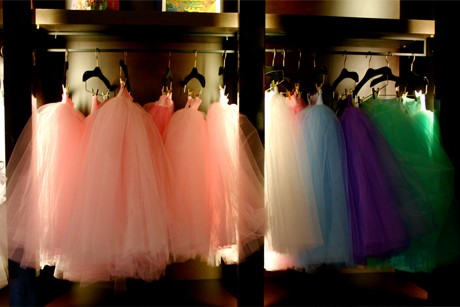Dance

Sat 14 May 2022

Where to see Dance Performances in Paris
Folies Bergère
32, rue Richer, in the 9th Arrondissement. 08 92 68 16 50. Folies is a bit of a mixed bag, despite the 130-year pedigree and reputation. The decor is highly reminiscent of the Moulin Rouge (the less said about dance at the Moulin Rouge, the better—it’s pretty safe to say it won’t appear on this page). Some of the past programs have been high profile, if a little cheesy at times. Having said that, however, the stupendous flamenco maestra Cristina Hoyos performed here last year, as did tribal belly dancer Rachel Brice (a personal heroine of mine), in 2005.
Folies is a bit of a mixed bag, despite the 130-year pedigree and reputation. The decor is highly reminiscent of the Moulin Rouge (the less said about dance at the Moulin Rouge, the better—it’s pretty safe to say it won’t appear on this page). Some of the past programs have been high profile, if a little cheesy at times. Having said that, however, the stupendous flamenco maestra Cristina Hoyos performed here last year, as did tribal belly dancer Rachel Brice (a personal heroine of mine), in 2005.
La Java
105, rue du Faubourg du Temple, in the 10th. 01 42 02 20 52.  La Java is a raucous nightclub (in the best way!) thoroughly steeped in history. Performers such as Edith Piaf and Django Reinhardt have graced its stage, as have more-contemporary acts like as Atmosphere and Jill Sobule. For a wild night of fun and dancing with friends, make La Java your destination.
La Java is a raucous nightclub (in the best way!) thoroughly steeped in history. Performers such as Edith Piaf and Django Reinhardt have graced its stage, as have more-contemporary acts like as Atmosphere and Jill Sobule. For a wild night of fun and dancing with friends, make La Java your destination.
Momboye Center
25, rue Boyer, in the 20th. 01 43 58 85 01.  The Momboye Center offers dance classes in techniques and styles from across Africa—Guinea, Cameroon, Mali, Senegal, Ivory Coast and Congo, to name a few. Georges Momboye founded the center, and it’s perhaps the first poly-African dance studio in the world.
The Momboye Center offers dance classes in techniques and styles from across Africa—Guinea, Cameroon, Mali, Senegal, Ivory Coast and Congo, to name a few. Georges Momboye founded the center, and it’s perhaps the first poly-African dance studio in the world.
Opéra Garnier
8, rue Scribe, in the 9th. 
Opéra Bastille
Place de la Bastille, in the 12th. Opéra Garnier includes the National Ballet and ballet school, and has a sister institution, Opéra Bastille. Garnier remains the quintessential Victorian dance experience for traditionalists. Upcoming performances of note include Giselle, La Dame aux Camélias and The Nutcracker. For those who prefer slightly more exotic fare, Garnier does not disappoint. Diaghilev’s innovative Ballets Russes, which first performed in Paris in 1909 featuring the legendary Nijinski, will return in 2010. Other performances to look out for include Kaguyahime, a fusion of Japanese and western dance, and Siddharta.
Opéra Garnier includes the National Ballet and ballet school, and has a sister institution, Opéra Bastille. Garnier remains the quintessential Victorian dance experience for traditionalists. Upcoming performances of note include Giselle, La Dame aux Camélias and The Nutcracker. For those who prefer slightly more exotic fare, Garnier does not disappoint. Diaghilev’s innovative Ballets Russes, which first performed in Paris in 1909 featuring the legendary Nijinski, will return in 2010. Other performances to look out for include Kaguyahime, a fusion of Japanese and western dance, and Siddharta.
Théâtre de la Ville
2, place du Châtelet, in the 4th. 01 42 74 22 77. 
Théâtre des Abbesses
31, rue des Abbesses, in the 18th. 01 48 87 54 42.  The feel of the performances at these affiliated theatres is decidedly that of new and more experimental choreographers, and the program is diverse. While in my experience these venues can involve more risk than the old favorites, the quality of production values here is consistently high. The Alvin Ailey American Dance Theater was one of the highlights of Paris’s summer dance festival, hosted here. The 2010 season also includes performances from the Ballet de l’Opéra de Lyon as well as choreographers from India and Japan.
The feel of the performances at these affiliated theatres is decidedly that of new and more experimental choreographers, and the program is diverse. While in my experience these venues can involve more risk than the old favorites, the quality of production values here is consistently high. The Alvin Ailey American Dance Theater was one of the highlights of Paris’s summer dance festival, hosted here. The 2010 season also includes performances from the Ballet de l’Opéra de Lyon as well as choreographers from India and Japan.
Théâtre des Champs-Élysées
15, ave Montaigne, in the 8th. 01 49 52 50 50.  World ballet is the theme of this theatre, and the 2009–10 season includes three performances from the Russian Ballet. The Kremlin Ballet looks to Diaghilev as the Ballets Russes celebrates its centennial. The St. Petersburg Ballet tells the stories of Don Quixote and Giselle in what are sure to be stunning performances. Sara Baras will also delight flamenco fans, with a show featuring buleria, fandango and the farruca. Can’t wait!
World ballet is the theme of this theatre, and the 2009–10 season includes three performances from the Russian Ballet. The Kremlin Ballet looks to Diaghilev as the Ballets Russes celebrates its centennial. The St. Petersburg Ballet tells the stories of Don Quixote and Giselle in what are sure to be stunning performances. Sara Baras will also delight flamenco fans, with a show featuring buleria, fandango and the farruca. Can’t wait!
Théâtre du Châtelet
Place du Châtelet, in the 4th. 01 40 28 28 40.  Just across the way from the Théatre de la Ville, the Théâtre du Châtelet specializes in concerts and musical performances, though the pure dance program for next year is rather thin at present. The lineup of musicals compensates for this, however, with Les Misérables and The Sound of Music guaranteed to draw crowds, along with A Little Night Music and Magdalena. Situated close to the Iéna metro, the theatre boasts a view that affords a spectacular nocturnal Eiffel Tower photo op.
Just across the way from the Théatre de la Ville, the Théâtre du Châtelet specializes in concerts and musical performances, though the pure dance program for next year is rather thin at present. The lineup of musicals compensates for this, however, with Les Misérables and The Sound of Music guaranteed to draw crowds, along with A Little Night Music and Magdalena. Situated close to the Iéna metro, the theatre boasts a view that affords a spectacular nocturnal Eiffel Tower photo op.